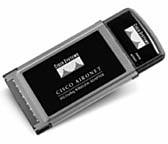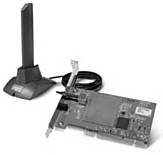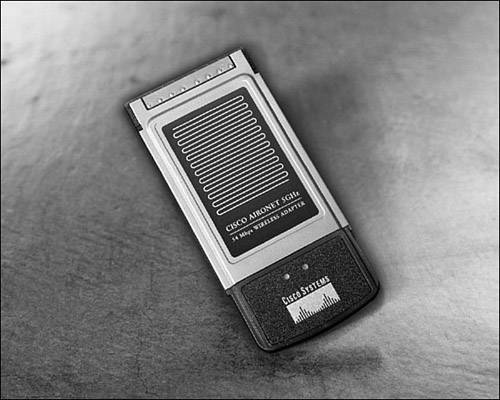Cisco Client Adapters
| As we move down the wireless food chain, we come to the devices connecting users with the wireless network. Wireless adapters can be fitted to a multitude of devices client PCs, personal digital assistants, network printers, and so forth. Cisco offers four client adapters for its Aironet line:
The type of client adapter you use depends on what type of computer you need to connect. Laptops and other devices with Personal Computer Memory Card International Association (PCMCIA) and CardBus combination slots use a CardBus device. Desktop and tower-style PCs use PCI adapters. Cisco Aironet 350The entry-level model of Cisco client adapters is its venerable Aironet 350 adapter, shown in Figure 1-15. These adapters are designed as PCMCIA or PCI devices, which allow them to work with both desktop and laptop PCs. Figure 1-15. Cisco Aironet 350 Client Adapters in PCMCIA and PCI Forms These adapters can be used in either ad hoc (meaning two or more computers connect among themselves) or infrastructure environments (meaning the clients connect to a WLAN) and use the 802.11b protocol, which allows them to work in the 2.4-GHz band with a range up to 800 feet at 11 Mbps. Although this product operates at just 11 Mbps, it is compatible with 802.11g APs (although speed is limited to the adapter's top speed of 11 Mbps). Cisco Aironet 802.11a, 802.11b, and 802.11g CardBus and PCI Wireless Client LAN AdaptersThe Aironet 802.11 a/b/g CardBus and PCI Wireless Client LAN Adapters allow for a variety of uses and applications. Although they provide the same functionality, the difference between the CardBus and PCI devices is their physical design and construction. The CardBus devices are suited for laptops and tablet PCs, but the PCI device is meant for desktop PCs. The CardBus device (shown in Figure 1-16) plugs into an open CardBus or combo CardBus/PCMCIA slot and the end sticks out an inch or so, allowing its internal antenna to communicate with the WLAN. The PCI device (shown in Figure 1-17) is a card that plugs into an open PCI slot on the PC. The card is connected to a small antenna that can be adjusted for best connectivity to the WLAN. Figure 1-16. Cisco Aironet 802.11 a/b/g CardBus Wireless Client LAN Adapter Figure 1-17. Cisco Aironet 802.11a, 802.11b, and 802.11g PCI Wireless Client LAN Adapter In spite of their physical differences, the devices offer the same functionality and are the most feature-rich and functional. They both offer:
These devices support Wi-Fi Protected Access (WPA) and WPA2. They also support 802.1X authentication, which includes LEAP, EAP-TLS, PEAP-GTC, EAP-FAST, and PEAP-MSCHAP V2. Wireless security is explored in Chapter 4. In addition, RADIUS servers can be used for strong security and user management. Cisco Aironet 5 GHz 802.11a AdapterThe Cisco Aironet 5 GHz 802.11a Adapter serves clients that need access to a WLAN using 802.11a technology, shown in Figure 1-18. This device uses a CardBus form and is designed for use with APs, such as the Cisco Aironet 1200 Series 802.11a AP or the Aironet 1130AG AP. Figure 1-18. Cisco Aironet 5 GHz 802.11a Adapter Because the device offers 802.11a functionality, it operates at speeds of up to 54 Mbps in the 5-GHz band. Data rates can be reduced to extend the device's range. The adapter uses the Cisco Wireless Security Suite, which offers the EAP framework for user-based authentication. It also supports a number of 802.1X authentication modes that include Cisco LEAP, EAP-TLS, PEAP, and EAP-SIM. Authentication methods are explained in more detail in Chapter 4. Client Adapter Quick ComparisonCisco offers a number of options for client adapters. Choosing which adapter is ideal may come down to a number of variables or just one. Table 1-7 compares these devices and their attributes.
|
EAN: 2147483647
Pages: 126



